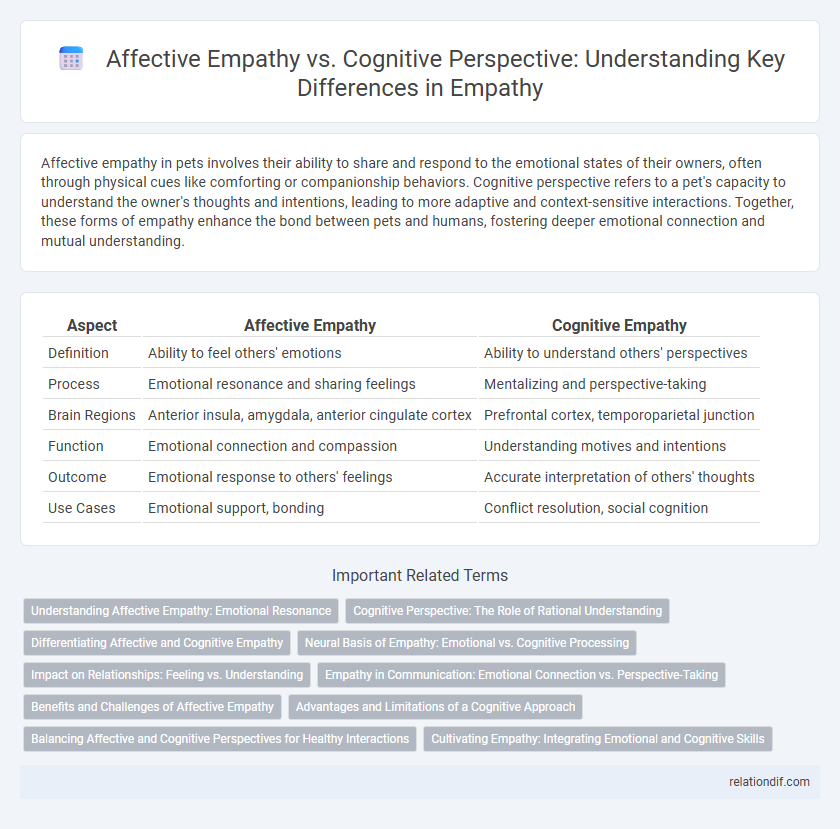Affective empathy in pets involves their ability to share and respond to the emotional states of their owners, often through physical cues like comforting or companionship behaviors. Cognitive perspective refers to a pet's capacity to understand the owner's thoughts and intentions, leading to more adaptive and context-sensitive interactions. Together, these forms of empathy enhance the bond between pets and humans, fostering deeper emotional connection and mutual understanding.
Table of Comparison
| Aspect | Affective Empathy | Cognitive Empathy |
|---|---|---|
| Definition | Ability to feel others' emotions | Ability to understand others' perspectives |
| Process | Emotional resonance and sharing feelings | Mentalizing and perspective-taking |
| Brain Regions | Anterior insula, amygdala, anterior cingulate cortex | Prefrontal cortex, temporoparietal junction |
| Function | Emotional connection and compassion | Understanding motives and intentions |
| Outcome | Emotional response to others' feelings | Accurate interpretation of others' thoughts |
| Use Cases | Emotional support, bonding | Conflict resolution, social cognition |
Understanding Affective Empathy: Emotional Resonance
Affective empathy refers to the immediate emotional response one experiences when perceiving another person's feelings, creating an emotional resonance that mirrors their emotional state. Unlike cognitive empathy, which involves understanding another's perspective intellectually, affective empathy engages the autonomic nervous system and activates brain regions such as the anterior insula and anterior cingulate cortex. This emotional contagion facilitates deep interpersonal connection and compassionate behavior by allowing individuals to feel the emotions of others intuitively.
Cognitive Perspective: The Role of Rational Understanding
Cognitive perspective in empathy involves the rational understanding of another person's emotions and thoughts without necessarily sharing their feelings. It enables individuals to accurately interpret social cues and predict behavior through perspective-taking and mentalizing processes. This form of empathy supports effective communication, conflict resolution, and decision-making by focusing on logical assessment rather than emotional contagion.
Differentiating Affective and Cognitive Empathy
Affective empathy involves sharing and responding to another person's emotional experiences, engaging the mirror neuron system to feel emotions as if they were one's own. Cognitive empathy, by contrast, requires understanding another individual's perspective intellectually without necessarily sharing their emotional state, often engaging prefrontal brain regions responsible for theory of mind. Differentiating these forms of empathy is crucial for psychological assessments and therapeutic interventions, as affective empathy drives emotional connection while cognitive empathy facilitates effective social communication and problem-solving.
Neural Basis of Empathy: Emotional vs. Cognitive Processing
Affective empathy involves the automatic sharing of emotions and is primarily associated with the activation of the anterior insula and the anterior cingulate cortex, regions linked to emotional processing and pain perception. Cognitive empathy, or perspective-taking, engages the medial prefrontal cortex, temporoparietal junction, and the precuneus, supporting mentalizing and theory of mind functions. These distinct neural circuits reveal how emotional resonance and cognitive evaluation combine to enable a comprehensive empathetic experience.
Impact on Relationships: Feeling vs. Understanding
Affective empathy involves sharing and resonating with another person's emotions, creating a deep emotional connection that strengthens trust and intimacy in relationships. Cognitive empathy emphasizes understanding another's perspective without necessarily sharing their feelings, which aids in effective communication and conflict resolution. Balancing both affective and cognitive empathy enhances relationship dynamics by fostering compassion while maintaining clear, rational understanding.
Empathy in Communication: Emotional Connection vs. Perspective-Taking
Affective empathy involves sharing and resonating with another person's emotional state, enhancing emotional connection during communication. Cognitive empathy focuses on understanding another's perspective and thoughts, facilitating clearer comprehension and effective perspective-taking without necessarily sharing the same feelings. Both forms of empathy are crucial for meaningful communication, balancing emotional attunement with intellectual insight to foster stronger interpersonal relationships.
Benefits and Challenges of Affective Empathy
Affective empathy enables individuals to emotionally resonate with others, fostering deep interpersonal connections and enhancing social bonding. This emotional attunement improves support and caregiving, but it can also lead to emotional burnout or compassion fatigue in high-stress environments. Balancing affective empathy with self-regulation strategies is essential to maintain emotional well-being while providing empathetic responses.
Advantages and Limitations of a Cognitive Approach
Cognitive empathy enables individuals to understand others' thoughts and intentions, fostering effective communication and problem-solving in complex social interactions. Its advantage lies in promoting perspective-taking without the emotional distress that affective empathy might cause, enhancing decision-making in professional settings. However, the limitation of a cognitive approach is that it may lack emotional resonance, potentially leading to misunderstandings or perceptions of insensitivity when emotional support is required.
Balancing Affective and Cognitive Perspectives for Healthy Interactions
Balancing affective empathy, which involves sharing others' emotions, with cognitive empathy, the ability to understand others' perspectives, is essential for healthy interpersonal interactions. Affective empathy fosters emotional connection and compassion, while cognitive empathy supports effective communication and problem-solving by allowing one to interpret others' intentions accurately. Cultivating both forms enhances social harmony and prevents emotional burnout by ensuring responses are both heartfelt and appropriately measured.
Cultivating Empathy: Integrating Emotional and Cognitive Skills
Cultivating empathy involves integrating affective empathy, which is the ability to emotionally resonate with others' feelings, and cognitive empathy, the skill to intellectually understand another person's perspective. Research shows that combining these emotional and cognitive processes enhances interpersonal relationships and social communication. Developing both skills supports emotional intelligence and fosters deeper connections across diverse social contexts.
Affective empathy vs cognitive perspective Infographic

 relationdif.com
relationdif.com